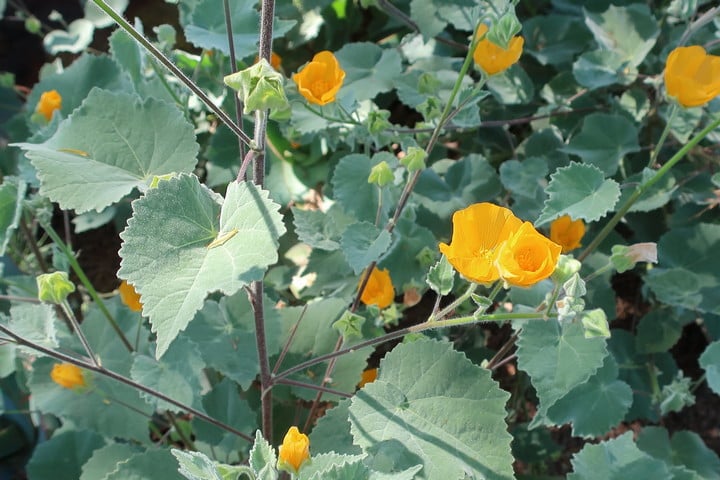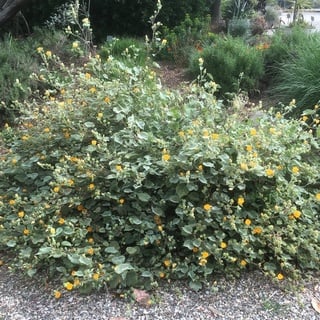Superstition mallow is a lovely desert shrub that is underutilized as a landscape plant. It looks beautiful all year and thrives on neglect. Here’s everything you need to know about planting and caring for this Sonoran Desert native.

Superstition mallow (Abutilon palmeri) is a medium size, evergreen shrub that has so much going for it, it’s puzzling that it isn’t grown more frequently. It has velvety, heart-shaped leaves and golden-orange cup-shaped flowers that bloom on and off most of the year.
This is an extremely low-maintenance plant. Once established, it needs minimal irrigation. In its native habitat, it can survive on as little as 4″ of annual rainfall. It requires almost no pruning and produces no obvious litter.
It’s “user-friendly.” It’s completely unarmed (i.e., no thorns, prickles, or irritating hairs) and is one of the few desert natives that is actually soft to touch!
This is an easy plant to grow. According to Arizona State University, this plant thrives on neglect and minimal supplemental water, even in Phoenix, and suffers more from too much care rather from than too little. (Sounds good to me!)
It sometimes reseeds in the garden, but not to the point of being a nuisance.
Superstition mallow flowers attract bees and butterflies. It is also a larval host for several species of moths and butterflies.
Why I Like This Plant
- Evergreen and flowers almost all year
- Soft, silver heart-shaped leaves
- Sonoran Desert native
- Extremely low maintenance
- Attracts butterflies, moths, bees
- No thorns, non-toxic, low litter
Things to Watch Out For
Young plants are a favorite of rabbits, so if these critters are a problem for you, protect new plants.
Optimal Growing Conditions
If you’re thinking of adding a Superstition mallow to your garden, you need to find a suitable place that will keep your plant healthy and looking good… while minimizing maintenance for you.
Here are the key factors to keep in mind.
Temperature
Superstition mallow should be planted in USDA Hardiness Zones 9 – 11. It is extremely heat tolerant and cold-hardy down to 25℉. It may suffer cold damage if temperature dips to the low twenties, but it should rebound in the spring.
Sun Exposure
It thrives in full sun where it has a dense, rounded form. It doesn’t mind reflected heat, making it a good choice to grow near garden walls. It can be grown in part shade but will have a more open, sprawling form.
Size and Growth Rate
Superstition mallow is considered a fast grower. It typically reaches a size of 4 to 5 feet tall and wide when mature. It’s growth rate and ultimate size largely depend on how much water it receives, and irrigated plants can grow up to 8 feet tall.
Soil
Superstition mallow is not particular about soil. In its native habitat, it grows in sandy or gravelly soil. In the garden, it grows well in any native soil — sand, clay, or rocky, — provided it’s well-draining.
Superstition Mallow:
The Essentials
| Common Names | Superstition mallow, Indian mallow |
| Scientific Name | Abutilon palmeri |
| Origin | Sonoran Desert |
| Plant Type | Evergreen shrub |
| USDA Zones | Zones 9 – 11 |
| Cold Hardiness | To 25℉ |
| Flower Color | Golden-orange |
| Flower Season | Spring, summer, fall |
| Mature Size | 4-5′ tall x 4-5′ wide |
| Growth Rate | Fast |
| Sun Tolerance | Full, part, reflected sun |
| Water Needs | Low |
| Pests & Diseases | Rabbits |
| Garden Friendly | No thorns, non-toxic, low litter |
| Wildlife | Attracts butterflies, bees, moths |

How to Plant
The rule of thumb when planting any shrub in the desert is to dig a hole three times as wide as the root ball but no deeper. Amending the soil is not recommended. Counterintuitively, backfilling with the same native soil you just dug up helps your plant develop a stronger root system.

When to Plant Superstition Mallow
The best time to plant Superstition mallow is in the fall. This gives your shrub three seasons to grow roots and get established before the following summer.
The second best time is in spring, the earlier the better. This still gives your plant time to get established before the intense heat of June arrives.
How to Care for Superstition Mallow
Whether you’ve recently planted a Superstition mallow or have an existing plant in your yard, here’s how to take care of it to keep it healthy and looking its best.
How to Water New Plants
Once you’ve got your Superstition mallow planted, watering is your most immediate concern. Here is the recommended watering schedule for new shrubs planted in the spring or fall.
| Weeks 1 & 2 | Every 3 – 4 days |
| Weeks 3 & 4 | Every 5 – 7 days |
| Weeks 5 & 6 | Every 7 – 10 days |
| Weeks 7 & 8 | Every 10 – 14 days |
After week 8, gradually extend the time between waterings.
How to Water Established Plants
Once your plant is established, water it once per week during the summer to encourage flowering — no supplemental water is needed during the winter, provided you’ve had normal rainfall.
Don’t overwater this plant. Too much water results in rampant growth and fewer flowers.
Should You Fertilize?
There is no need to fertilize Superstition mallow. They are well-adapted to thrive in native desert soil.
How to Prune
Superstition mallow has an attractive natural mounding form and does not need regular pruning to keep in shape.
You can prune any cold damage in early spring, and you can pinch new growth during the summer to encourage bushiness.
You can cut it back severely every few years in early spring to help control its size.
Plant Lover Facts
Superstition mallow is most commonly called Indian mallow but also goes by the names Palmer’s abutilon, Palmer’s mallow, Palmer’s Indian mallow, and Santa Catalina Indian mallow.
It is native to Arizona, California, and northern Mexico. Its common name is derived from the Superstition Mountains outside of Phoenix.
Did you enjoy this article?
Sign up for our weekly newsletter
where you’ll find more great info on creating &
maintaining a beautiful, carefree desert landscape.
Author Bio
Deane Alban is the creator of Southwest Gardener. She is a science writer with a bachelor’s degree in botany from the University of South Florida. Gardening is her lifelong passion. She’s been gardening in Tucson for over 15 years.

Photo Credits
“Fallbrook Garden Tour” by KM is licensed under CC BY 2.0
Curtis Clark, CC BY-SA 2.5, via Wikimedia Commons
